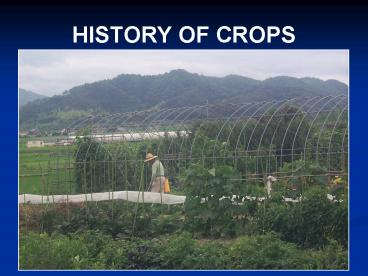HISTORY OF CROPS PowerPoint PPT Presentation
1 / 16
Title: HISTORY OF CROPS
1
HISTORY OF CROPS
2
5 Most Important Crop Groups
- 1. Cereals - Wheat, corn and rice
- Rice alone supplies the energy required by 50
of the world's people. - Associated with different major cultures
- 2. "Root" Crops - White or Irish potato (not a
root), sweet potato, cassava (manioc or tapioca) - 3. Sugar producers - sugar cane, sugar beet
- 4. Legumes - common bean, soybean
- 5. Tropical tree crops - coconut, banana
3
Wheat
- The most widely cultivated plant in the world.
- Early varieties parched to make gruel or beer
- Natural hybridization, chromosome doubling --gt
modern wheat - Brought to Mexico in 1529
- U.S., Canada, and Argentina among worlds great
producers
4
Rice
- Limited distribution, but feeds more people
- Introduced to Carolinas in 1647
- Used for food, beers wines
- Produce starch rice powder
- Hulls used for fuel, building materials, and
making chemicals for - plastic manufacture
- Straw used
5
Maize (Indian corn)
- A major animal food
- Was the most widely grown plant in America
- Center of Native American life
- Europe did not embrace it.
- U.S. is 1st in production, Argentina 2nd, China
3rd - Extremely wide uses
6
Potato
- 2000 B.C. in America Europe in 1570
- Began to be common in Europe in 1700s
- 1800s - staple in Ireland (almost sole food of
peasantry) - Potato blight of 1845-6
- Irish potato to Bermuda in 1621, sold in Boston
in 1707 - To NH in 1716 by Presbyterian colonists
- 1848 - nearly 100 named cultivars - MA Hort. Soc.
7
Sweet potato
- Origination tropical Americas Pacific islands
- Adapted to warm climates
- Extensively grown in Africa Asia
- Provides 50 more calories than white potato, but
less protein - Major start in US came when grown as slave food
8
Manioc
- Tropics of both hemispheres
- Africa from Brazil - 16th century
- World production 110 million tons
- Boiled or roasted or made into meal
- Tapioca pudding is from manioc
- Used for making adhesives, cosmetics, paper and
for sizing textiles
9
Growing processing
10
Sugar cane
- Domestication in New Guinea or Indonesia
- Europe learned of it from Alexander the Great
- Columbus introduced it to the New World
- Supplies over 50 of the worlds sugar is used
for making alcohol
11
Sugar beet
- European plant used for greens
- Discovered sugar in root in 18th century
- 1801 - 1st processing plant - Prussia
- Napoleon encouraged growth in France
- Came to U.S. in late 1800s
- Sugar content has been increased from 2 to 20
12
Legumes
- Highest of all plant food types in protein
- Amino acids complement those in cereals
- Highest consumption in India Latin America also
high - US produces 60 of worlds soybeans
- 2/5s of crop exported - thus most important crop
in world trade - Nitrogen fixing bacteria associated with roots
- Toxic members of the family
13
Banana
- Perennial herb - stem is leaf stalks
- Originated in SE Asia
- Reference to it in India from 500 B.C.
- To Europe 2000 years ago (Alexander)
- Americas in 1516
- 1871 - railroad built - banana plantings made to
provide freight - Nutritive value close to white potato, but more
carbs are in the form of sugar - 37 million tons produced annually - only 15
enters world trade
14
Coconut
- Palm family Carnuba wax to rattan to dates and
coconuts - Tree known in India since 1000 B.C.
- Tree bears 50 to 100 coconuts/year
- Meat is dried making copra - oil extracted
(60-70 by weight) - Oil most important product - makes soaps,
margarine (though less now) - Residue coconut cake fed to livestock
15
U.S. Fruit culture
- Nurseries in NY NE in 1640s
- Early 1800s - shift from food fruits to apple
pear orchards for cider perry - Cider major export to West Indies southern
colonies - Alcohol content of 16-20
- Consumption 201 to other alcoholic beverages
- 1790 to 1850 - itinerant peddlers worked as fruit
tree grafters in early spring
16
(No Transcript)

